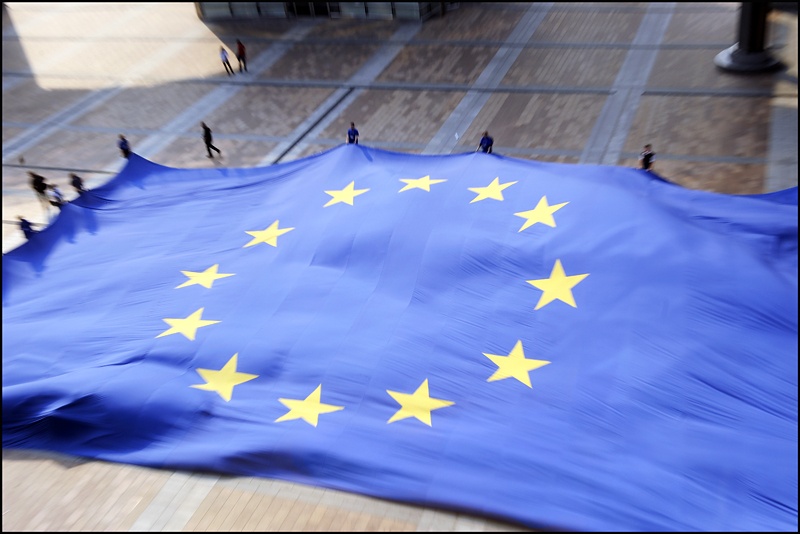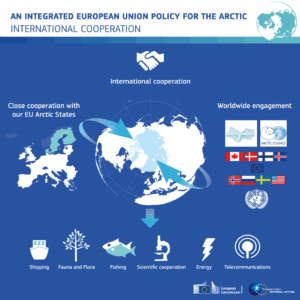The EU’s new Arctic Communication - Part III

Photo: Pietro Naj-Oleari, Flickr
Part III: What about Arctic Cooperation? A small EU fish in a big Arctic pond
In our third analytical installment on the EU’s new Communication on Arctic matters we focus on the international and global dimension of the new statement. Hence, we ask how the EU sees its place and role in pan-Arctic cooperation.
The new Joint Communication on “An integrated European Union policy for the Arctic” (JOIN(2016) final) was published on 27 April 2016 and can be found here.
We have scrutinized the new Joint Communication in three installments. Part I analyses the very meaning of an “integrated EU Arctic policy”, highlighting limitations and signs of progress. Part II discusses the EU’s approach towards the European Arctic and proposals for better coordination of Arctic affairs. Part III puts the Communication in a broader circumpolar setting of Arctic cooperation and the Union’s upcoming Global Strategy.
The different parts of this analysis will simultaneously be published as one policy paper via the ArCticle series of the Arctic Centre (University of Lapland, Rovaniemi, Finland) and can be found here.
Safe and Stable – European Neighbourhoods and a Global Strategy
According to the Communication’s very first paragraph, a “safe, stable, sustainable and prosperous Arctic is important (…) for the European Union”, with the Union having a “strategic interest in playing a key role in the Arctic region”. Why is it so important for the EU that the Arctic region remains a “zone of peace, prosperity and constructive international cooperation”?
The functionality of the European Union is determined by its various neighbourhoods and frontier areas. Instability, chaos and/or unpredictability in these regions significantly influence the Union’s internal stability, posing challenges to the very existence of the Union as such. At the moment, the migration and refugee crisis along Europe’s southern borders serves as a constant reminder of how external threats are having a lasting and distressing impact on the EU’s internal stability. In a nutshell, in today’s post-Cold War environment, internal and external elements of security and stability are inextricably linked. Hence, it is in Europe’s very own interests to create neighbourhoods of stability and predictability.
From a conceptual perspective, adopted security strategies provide the framework that identify a particular security environment, key challenges and related policy implications. With the last European Security Strategy (ESS) already 13 years old, the EU’s High Representative for Foreign Affairs and Security Policy (HR) is currently developing a new Global Strategy on Foreign and Security Policy that should guide the EU’s global action in the future. Unlike the ESS, the new Global Strategy will also cover the Arctic and the essential question how to deepen and reinforce the prevailing cooperative relationships in the region.1)
Additionally, the EU’s approach to the Arctic can be seen in light of the 2014 Maritime Security Strategy. Accordingly, security has been understood in a broad manner that also encompasses environmental security. Arctic waters are mentioned as an area of particular importance, alongside the EU’s adjacent seas and the Atlantic Ocean. Following EU interests, the Union commits to “maritime multilateralism”, i.e. cooperation with all interested parties. The mutual respect of international law and rules is considered key in this regard. The new Arctic Communication mirrors this approach, stating that the EU will engage “in a strategic dialogue with Arctic stakeholders and third countries on security matters and by promoting continued rules-based governance at sea”.
The Northern Neighbourhood
Over the last decade, the Arctic region turned from an allegedly geopolitically and geo-economically ‘hot’ Arctic into a realistically ‘cold’ Arctic.2) Initially, the region’s volatile state of affairs had been characterised as a state of chaos, dominated by the competition over natural resources and maritime routes with states facing each other in a Wild West style.3) This perception of the Arctic – Europe’s northern frontier – led to an increased interest in Arctic affairs within the hallways of EU power. Ever since 2008, the EU’s various institutional actors – the European Commission, the Council of the European Union and the European Parliament – have published policy documents that outlined the different ideas about the EU-Arctic nexus. Interdependence was key to all of these seven documents. The Arctic does not only affect Europe but is essentially also affected by Europe. Climate change in the Arctic does not originate in the circumpolar North but has its causes in the industrialised regions of the world. In turn, climate change in the Arctic does not end at the Arctic Circle but magnifies global climate change.
The New Communication and Arctic Cooperation
The emphasis on mutual interdependence between the EU and the Arctic region also characterizes the new Joint Communication on “An integrated European Union policy for the Arctic”. Not least, one of the functions of the EU’s Arctic policy is to serve as a regional sub-policy for the Union’s broader strategic outlook as it is going to be presented in the Global Strategy.4) The policy paper starts from the premise that although the Arctic states have a primary responsibility for addressing issues within their territories, many Arctic challenges can be more effectively addressed through regional or multilateral cooperation. Unsurprisingly, the Communication mentions the usual suspects in that regard and emphasises the now-established ‘same old’ cooperative and engaged position of the EU towards the following governance frameworks:
- The Law of the Sea Convention (UNCLOS) provides a framework to manage the Arctic, and the EU will seek strategic dialogue with both Arctic stakeholders and third countries to ensure compliance with the Convention;
- The Arctic Council is the primary forum for regional cooperation and the EU will continue to engage in all niches and corners of the Arctic Council (and eventually become an accredited observer), in addition hoping that the Finnish chairmanship “will offer an opportunity to bring European ideas and initiatives” to its work;
- The Barents Euro-Arctic Council, the Union’s very own Northern Dimension, the Nordic Council and the UN Economic Commission for Europe on Long-Range Transboundary Air Pollution are also important regional cooperation frameworks that continue to be supported by the EU.
Additionally, the Joint Communication stresses the Union’s engagement in issues of direct relevance to the Arctic at international level, particularly via the United Nations. For example, a EU Arctic policy is considered an “important element” in implementing the COP 21 agreement.
Ocean Governance and Fisheries
The EU’s approach towards the international framework for the Arctic Ocean needs to be discussed in the broader context of the Union’s current process of formulating its approach to international ocean governance. The key venue for EU action will be the UN negotiations on a possible new UNCLOS implementing agreement covering biodiversity in areas beyond national jurisdiction (high seas), which are commencing at the time of writing. The EU is likely to take a position on a strong international governance framework, including alleviating hindrances for establishing marine protected areas in high seas areas. The new Communication reflects this position when it states that a future framework for the Arctic Ocean and its high seas should “include a new Regional Fisheries Management Organisation [RFMO] or Arrangement, combined with a new Regional Sea Convention, to ensure the long-term conservation and sustainable use of resources in the Arctic high seas”.
This statement should be read in light of recent Arctic developments. First, there is an ongoing work in the Arctic Council as regards Arctic marine governance, with a regional seas agreement initially considered as one possible option (currently, however, it appears to be off the table). Second, as regards fisheries, in 2015 the five Arctic Ocean coastal states (A5) signed a Declaration on Arctic high seas fisheries, unilaterally banning high seas fishing by own vessels until sufficient data on climate change impacts is available. At the same time, the A5 saw no need for an Arctic Ocean RFMO in the near-term. Other fisheries actors, including the EU, were later invited to join this dialogue, which materialized at a meeting in Washington, D.C. in December 2015. The Communication welcomes the A5 Declaration, but the Commission and HR stress that these developments concern an area beyond national jurisdiction. Hence, a potential RFMO needs to involve all major fishing nations in order to establish appropriate international measures.
The Role of Science
With climate change being the reason why the EU should be engaged in Arctic matters, research, science and innovation are considered the key component of how the EU aims to create regional credibility. In line with its previous approaches, research has been attributed the key role for effective cooperation between Arctic ‘insiders’ and Arctic ‘outsiders’. In the words of the Commission and HR, “science can be used as a catalyst to support a common understanding, enabling jointly agreed solutions to be reached and foster[ing] peace [and] cooperation”. Throughout the Joint Communication, the Commission and HR position the EU as a key partner for Arctic cooperation with research and science framed as the Union’s main regional contribution – facts that have been emphasized in the 2012 Communication and its two add-ons. Moreover, scientific cooperation also has the potential to strengthen the Union’s collaborative efforts towards its Arctic partners.
The EU and the Big Arctic Three
The EU’s Arctic collaboration with Canada and the U.S. currently seems to be at its ‘Arctic’ high point. After losing the case at the WTO regarding the EU’s ban on the trade in commercial seal products5), Canada has stopped blocking the accreditation of the Union’s observer status in the Arctic Council. Furthermore, the three partners established enhanced maritime (Atlantic and Arctic) science cooperation in the framework of the Galway Statement – a clear example of the importance of science diplomacy and scientific presence in the Arctic for actors external to the region (which includes the EU as regards the Arctic Ocean).
The relations with Russia – tainted by the ongoing crisis in Ukraine and mutual sanction regimes – are less a reason for celebration. Eventually, it was Russian resistance that prevented the EU from concluding the Arctic Council (non)-observership saga during the Iqaluit Ministerial Meeting in 2015. Yet, the new Joint Communication opens up the possibility for cooperation with Russia. According to the Union’s HR Federica Mogherini, the policy update is part of the principle of selective engagement between the EU and Russia as recently agreed on by the foreign ministers of the EU-28 and the HR.6)
Conclusion
In sum, the Joint Communication’s ‘performance’ concerning the area of ‘international cooperation’ will not surprise an EU-Arctic-policy-informed reader. Based on its early Arctic experiences and the turmoil following suggestion of an Arctic Treaty based on the Antarctic template (EP 2008 Resolution) and the emphasis on “enhanced governance” (Commission 2008 Communication), the Union’s Arctic steps ever since then have been shaped by terminological diligence and an overall cautious approach that rather defines the Union as Arctic suppliant than equal Arctic actor. An analysis of the 2012 Joint Communication finds the “EU’s unwillingness to step on the toes of any of the Arctic states by remaining largely unspecific, pushing back against the perception of the EU as a “super-regulator” and concentrating on environmental, climate change and research issues, supporting any effort to ensure the effective stewardship of the Arctic environment”.7) This conclusion also holds true for the 2016 Joint Communication. Eventually, science seems to be the internally agreed upon key should finally open the Arctic governance and cooperation door. The door to a neighbourhood that is generally perceived as peaceful and stable, embedded in a distinct cooperative environment. Accordingly, also the currently developed Global Strategy will essentially stress the cooperative path the EU wants to take in the Arctic region, with the Union contributing to soft security issues such as research, science and infrastructure.8)
References
